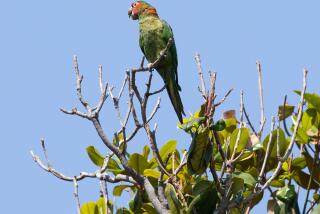Roosting Birds Get Heathrow Bum’s Rush
- Share via
LONDON — Steve Hart, official bird scarer at Heathrow Airport for five years, has a theory that birds are attracted by planes.
“When they get hot, birds spread their wings to cool down,” he says. “Flocks flying over the airport see all these big white things with outstretched wings down here and reckon it’s a good place to rest.”
He does not take the theory too seriously, but Heathrow’s “sea gull” teams have sometimes found flocks of 8,000 to 10,000 gulls roosting under the parked aircraft at night.
On the ground they are not a problem, Hart says. The teams quietly herd them away from the taxiways and disperse them at dawn. But in the air they can be a real danger.
A bird can break the fan blades in a large jet engine if it is sucked in. A Portuguese fighter pilot died in April after a bird was sucked into his engine, causing his plane to crash near Lisbon. A small Cessna crashed in Kenya killing seven people after hitting a bird earlier this year.
There has not been a serious accident involving birds at Heathrow for some time and BAA, operator of London’s major airports, aims to keep it that way.
Dispersal, rather than scaring, is the term BAA likes to use for its bird teams’ work, and Hart and partner Steve Ashby have a range of methods at their disposal.
“When we see a flock of birds, the first thing to do is identify the species,” Hart says. “Then we let rip with a tape for about 90 seconds.”
The tapes carry recorded distress calls of the most common birds around the airport--lapwings, starlings and three types of gull--which they blast from a loudspeaker on the roof of their yellow four-wheel drive vehicle.
Sometimes that is enough, but birds that are regulars to the airport get wise to the noise and more intelligent ones like crows ignore it from the start.
Then Hart reaches for the gun case.
BAA says it does not use a shoot-to-kill policy. Instead Hart and partner fire special anti-bird shells that explode 100 feet from the ground.
Only very stubborn birds receive lead pellets.
Hart reckons that there are some 300 birds of 10 species at the airport at one time, thinly spread out over the 2,960 acres.
But, Hart says: “Even the smallest bird can do a great deal of damage if it hits the right spot.”
Airport sources report a recent case of a pigeon being sucked straight through a Boeing 747 engine. The bird was ejected without causing damage but then badly smashed up an engine on an Airbus following behind.
The teams, which patrol 24 hours a day, are concerned mostly with big flocks of birds that might appear suddenly and pose a real hazard.
Heathrow has the misfortune of being between a favorite feeding place for Canada geese and their preferred roosting place.
A goose can knock out a large turbofan engine, Hart says. If geese appear, the airport usually closes while they pass over.
BAA tries to eliminate things that attract birds. Local farmers are persuaded to grow crops birds do not like and neighboring ponds are strung with wires to deter swans.
More to Read
Sign up for Essential California
The most important California stories and recommendations in your inbox every morning.
You may occasionally receive promotional content from the Los Angeles Times.













